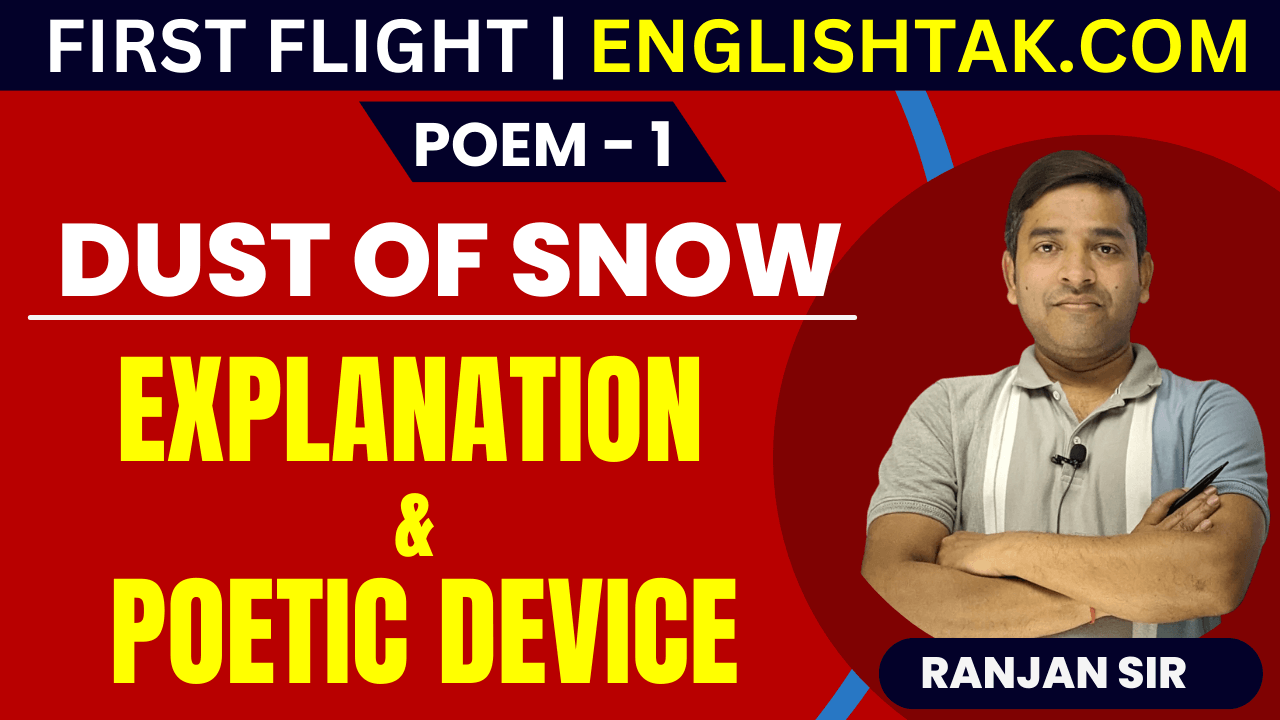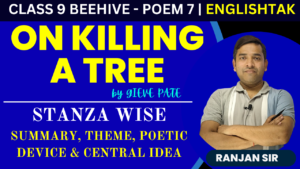![]()
Dust of Snow Explanation and Poetic Device
Table of Contents
Dust of Snow Explanation and Poetic Device – Here is the line by line explanation of Poem 1: Dust of Snow from the Class 10 English First Flight book, along with the Poetic Devices. The explanation also includes an analysis of the literary devices used in the poem.
Dust of Snow Explanation and Poetic Device
Stanza – 1
The way a crow
Shook down on me
The dust of snow
From a hemlock tree
In the first stanza of Robert Frost’s poem “Dust of Snow”, the speaker describes a seemingly ordinary event that carries deep symbolic meaning. Let’s break down the stanza in detail:
The Way a Crow
This line introduces the crow, a bird often associated with mystery, death, or bad omens in literature and folklore. The use of the crow here might suggest something dark or negative, reflecting the speaker’s initial gloomy mood. However, the crow is just a medium for change in this context, not a symbol of negativity. The phrase “The way” suggests that the crow’s actions are noteworthy or impactful to the speaker.
Shook Down on Me
The crow shakes something off a tree that falls on the speaker. The use of the word “shook” adds a sense of sudden movement or action. The crow’s random, natural movement indirectly affects the speaker, suggesting that even an unintentional act of nature can influence human emotions or thoughts. It foreshadows a significant change in the speaker’s mood.
The Dust of Snow
The “dust of snow” refers to light snow particles that fall on the speaker. Snow is often seen as cold and pure, and here, it symbolizes a refreshing or cleansing element. The word “dust” implies that it is not heavy snow but light, soft, and almost imperceptible — a small, subtle action that leads to a significant emotional shift. This dust of snow represents a moment of clarity or enlightenment for the speaker, indicating that even the smallest experiences can have a powerful impact.
From a Hemlock Tree
The hemlock tree is traditionally associated with poison or death, as in the case of the poisonous hemlock plant. In the context of the poem, the hemlock tree may symbolize something negative or depressing, further reflecting the speaker’s dark or troubled mood at the beginning. The fact that the crow shakes snow from this tree shows that something positive (the uplifting effect of the snow) can come from a place or situation that seems negative or foreboding.
Interpretation of the Stanza:
In this stanza, the crow and the hemlock tree both carry associations with death, darkness, or negativity, which align with the speaker’s melancholic state of mind. However, the action of the crow shaking down the light, refreshing snow symbolizes how even in the darkest moments, nature has the power to provide a spark of hope or clarity. The snow’s gentle fall represents a shift in the speaker’s perspective, reminding us that small, unexpected moments can alter our outlook and bring positivity from unlikely sources.
This stanza sets up the central theme of the poem: how a minor interaction with nature can transform one’s mood or state of mind.
Dust of Snow Explanation and Poetic Device
Stanza – 2
Has given my heart
A change of mood
And saved some part
Of a day I had rued.
In the second stanza of Robert Frost’s poem “Dust of Snow”, the speaker reflects on the emotional impact of the small, seemingly insignificant event that occurred in the first stanza. Let’s explore each line in detail:
Has given my heart (Dust of Snow Explanation and Poetic Device)
This line suggests that the action of the crow shaking down the dust of snow has affected the speaker emotionally. The phrase “given my heart” indicates that this moment has had a positive impact, providing something new or unexpected to the speaker’s inner emotional state. It implies that nature, even in its simplest form, has the ability to touch and influence human emotions.
A change of mood (Dust of Snow Explanation and Poetic Device)
The speaker reveals that his mood has shifted. Initially, he was likely feeling sad, burdened, or regretful, as hinted in the previous stanza. However, the dust of snow falling on him has caused a transformation, lightening his mood. This change demonstrates how a seemingly trivial event in nature can have a profound emotional effect, lifting the speaker from his gloomy state.
And saved some part
Here, the speaker suggests that part of the day, which he had previously considered ruined or wasted, has now been redeemed. The word “saved” carries a connotation of rescue or salvation, indicating that the emotional burden or negativity that was weighing on him has been alleviated to some extent.
Of a day I had rued (Dust of Snow Explanation and Poetic Device)
The word “rued” means to regret deeply. The speaker had been regretting the day, perhaps due to some personal disappointment or a general sense of unhappiness. Before the dust of snow fell, he had felt that the day was ruined or lost to these negative emotions. However, the simple act of snow falling on him has provided a sense of relief or redemption, altering his perception of the day.
Interpretation of the Stanza:
In this stanza, the speaker reflects on how a minor interaction with nature—a crow shaking snow from a tree—has unexpectedly lifted his spirits and saved his day from complete misery. It emphasizes the idea that even small, fleeting moments can bring about significant emotional change. The speaker’s mood has shifted from one of regret and sadness to a more positive, hopeful state. The poem illustrates how nature can offer moments of healing and clarity, even in times of emotional struggle.
This stanza also reinforces the theme that even a single positive experience, no matter how small or brief, can have a lasting effect and redeem an otherwise difficult or negative day.
Dust of Snow Poetic Device and Rhyme Scheme
In “Dust of Snow” by Robert Frost, several poetic devices are used to enhance the poem’s meaning and impact.
1. Alliteration:
Alliteration is the repetition of consonant sounds at the beginning of words in close succession. In this poem, it is used to create rhythm and emphasize certain words.
👉 “Has given my heart” – The repetition of the “h” sound creates a smooth flow.
👉 “Saved some part” – The “s” sound is repeated to highlight the transformation in the speaker’s mood.
2. Imagery:
Imagery refers to the use of vivid descriptions to create pictures in the reader’s mind. Frost uses visual and tactile imagery to make the scene more vivid.
👉 “Dust of snow” evokes a clear image of fine snowflakes falling gently, engaging the senses and emotions.
3. Symbolism:
Symbolism is the use of objects, characters, or events to represent larger ideas.
👉 The crow often symbolizes darkness or bad omens, yet here it brings about a positive change, symbolizing unexpected joy.
👉 The dust of snow symbolizes a small but significant moment that brings a change in perspective.
👉 The hemlock tree, associated with poison or death, symbolizes negativity or sadness, from which the speaker is uplifted.
4. Enjambment:
Enjambment occurs when one line of poetry flows into the next without a pause or punctuation mark, creating a sense of continuity.
👉 “Has given my heart / A change of mood” – The lack of punctuation at the end of the line propels the reader forward, mirroring the quick shift in mood.
5. Rhyme Scheme:
The poem follows a simple, regular rhyme scheme of ABAB in both stanzas. This structure contributes to the poem’s rhythm and musicality.
6. Metaphor:
A metaphor is an implicit comparison between two things. In this poem, the “dust of snow” can be seen as a metaphor for a small but meaningful moment that changes the speaker’s mood.
These poetic devices work together to convey the theme of the poem — the transformative power of nature and how small, unexpected moments can have a profound impact on one’s mood.
English Solution for Class 10 Board Exams
Dust of Snow Theme Summary and Explanation
Two Stories about Flying Very Short Questions Answers
Unseen Passage for Class 10 with Answer PDF 2025
Fill in the Blanks with Suitable Words
Complaint Letter Class 10 Solved Exercise
How to Write Analytical Paragraph Class 10
Editing Exercises for Class 10 CBSE 2024





